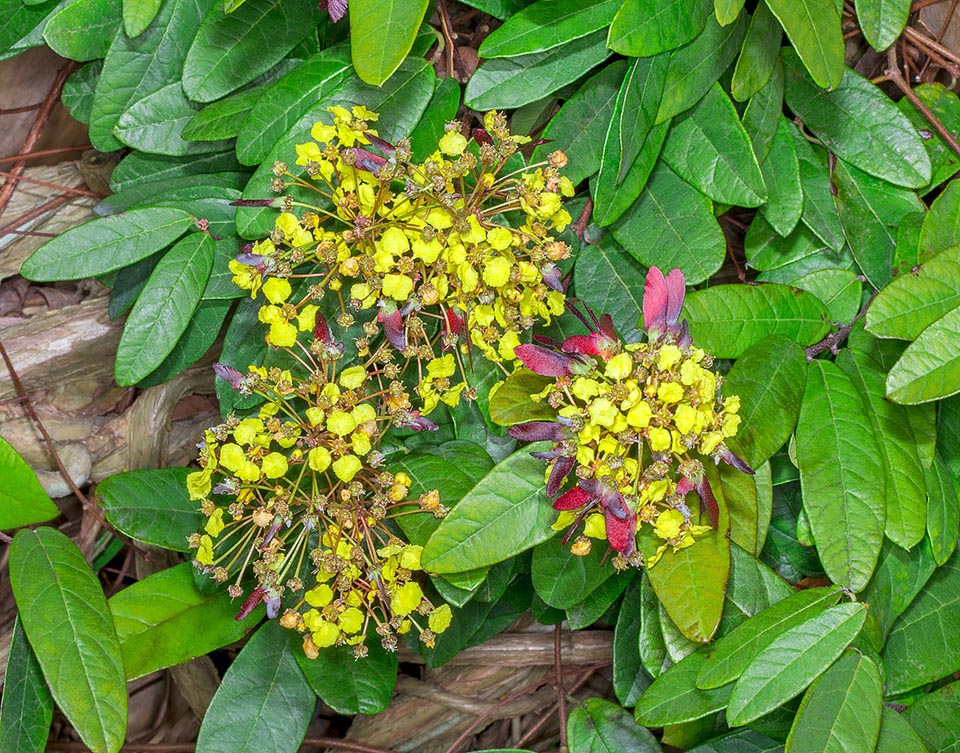Family : Malpighiaceae

Text © Pietro Puccio

English translation by Mario Beltramini
The species is native to Dominican Republic, Haiti, Honduras, Jamaica, Leeward Islands (Anguilla, Antigua, Barbuda, Guadeloupe, Nevis, St. Barthélemy, St. Eustatius and St. Martin), Puerto Rico, Virgin Islands (Anegada, St. John, St. Thomas, Tortola and Virgin Gorda) and Windward Islands (Martinique) where it lives in the thickets and in humid as well as in dry forests, from the sea level up to about 1500 m of altitude.
The generic name is the combination of the Greek substantives “στίγμα” (stigma) = stigma, and “φύλλον” (phyllon) = leaf, with reference to the appendages of the stigmata similar to leaves; the name of the species is the past participle of the Latin verb “emarginare” = to remove the margins, utilized in botany to indicate an organ, in this case the leaf, with sunken apex.
Common names: monarch Amazon-vine, red wiss, snake root, soldier vine (English); bejuco de San Juan, bejuco de San Pedro (Puerto Rico).
The Stigmaphyllon emarginatum (Cav.) A. Juss. (1840) is a woody climbing shrub with stems, up to 15 m long and of 3 cm of diameter, with reddish brown bark. The leaves are simple, opposite, oblong-linear to ovate-lanceolate with acute, obtuse or emarginate-mucronate apex and entire margin, coriaceous, initially pubescent, then glabrous, of glossy intense green colour above, paler below, 7-14 cm long and 2-4 cm broad; the petiole, 0,5-3 cm long, is provided of two glands at the base of the leaf. The inflorescences, on a 2-3 cm long pubescent peduncle, are axillar panicles bearing numerous hermaphrodite bright yellow flowers of about 3 cm of diameter.

The Stigmaphyllon emarginatum is a tropical woody climbing shrub with 15 m long stems of 3 cm of diameter. Luminous inflorescences and unusual winged fruits © Giuseppe Mazza
Calyx with 5 ovate sepals, about 2 mm long, provided of glands at the base, corolla with 5 orbicular unguiculate petals with crenulate margin, 1,2-1,5 cm long, 10 stamens, of which usually 4 shorter and sterile, superior trilocular ovary and 3 stigmas provided of one appendage similar to a leaf. The fruit is a schizocarp that when ripe divides in 3 monospermic samarae with membranaceous wings 2-2,5 cm long and about 0,8 cm broad.
It reproduces by seed, in organic loam with addition of coarse siliceous sand or agri perlite per a 30% maintained humid at the temperature of 24-26 °C, and by semi-woody cutting.
Robust climber that would deserve a major diffusion in the tropical and subtropical gardens due to its luminous blooming, made climbing on the trees, fences, pergolas or simply utilized as soil cover on rocky or sandy areas. It grows well in full sun as well as in partial shade and on various types of soil, provided draining, resists dry periods and the salty winds, therefore can be employed close to the sea.
Synonyms: Banisteria emarginata Cav. (1790); Triopterys lingulata Poir. (1808); Banisteria periplocifolia Desf. ex DC. (1824); Stigmaphyllon periplocifolium (Desf. ex DC.) A. Juss. (1840); Stigmaphyllon emarginatum f. parvifolium Nied. (1899); Stigmaphyllon periplocifolium f. intermedium Nied. (1899); Stigmaphyllon periplocifolium f. microphyllum Nied. (1899); Stigmaphyllon lingulatum (Poir.) Small (1910); Stigmaphyllon haitiense Urb. & Nied. (1912); Stigmaphyllon haitiense f. lineare Nied. & Urb (1912); Stigmaphyllon periplocifolium f. sericans Nied (1912); Stigmaphyllon lingulatum var. sericans (Nied.) Nied. (1920); Stigmaphyllon rubrinervum A. H. Liogier (1971).
→ To appreciate the biodiversity within MALPIGHIACEAE family please click here.
